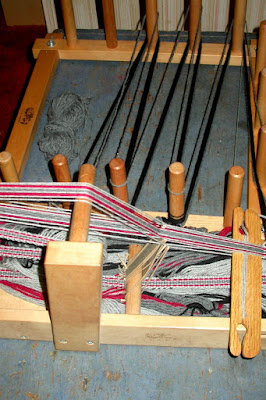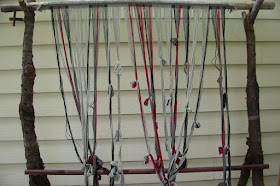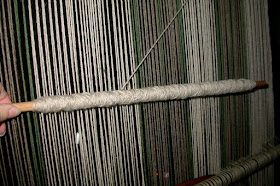I started out be getting some pictures from the company and I proceeded to do research on the web. There are lots of sources and people able to help. I got some additional information and passed it on to the carpenters...warp beams have to turn, the heddle rod has to be able to move...basic things like that. Some weeks later, I got 3 looms delivered to my house. I had them put in the garage and I spent several days sitting and looking at them to determine what would be best to do.
I thought about weaving a piece on my regular loom then attaching it to the warp weighted loom, but if I wove a band on the end that would be too time consuming. I decided to go with the traditional method of weaving...as close as I could get and still get the looms finished.
Rather than having a card woven band, I used my inkle loom and put a warp board next to it. This way I could get a band with 3 yard fringe that would become the warps on the loom.
 | |
| This is the third warp |
 | |
| Here is the warp/fringe from the second loom |
After weaving the width of the piece, I stitched it onto the warp beam from the loom.
 | |
| I stitched every 2 warp ends |
 | |
| The finished warp looked great hanging there |
I put the beam on the loom and started straightening the warps. You can see the groups or bundles of 20 threads here.
I now needed to hang the weights and chain the warp to keep it straight.
 |
| This shows the back half of the warp weighted. |
Chaining the warp is running a chain stitch across the with to space out the warps. According to some of the experts I talked to this is not a necessary step, but with my loom needing to be moved by stage hands, I wanted as much safety built in as I could get.
 | |
| This is process that I used, pretty basic |
 | |
| And here is the loom with both front and back weighted and chained. |
I worried for some time about the heddles, the basic source book (that I heard and read about but was not able to get a copy) talked about "knitted heddles". I finally found a web site that explained how to make them and showed an illustration. The problem was this method can slip. I will be having actors work on this loom and it will be moved around so I went with the more secure heddle method from back-strap weaving...a half-hitch.
I used a netting shuttle to stitch each of these half hitches around each warp end and then made a half-hitch between each to hold it secure.
 | |
| Stitching each half-hitch around the warp on the lease sticks |
 |
| Artsy shot of the same |
 | |
| Here's a close-up |
 | |
| And here you can see the half-hitch |
Once the heddles were tied on the first loom, I found that the angle of the uprights was too straight, they needed to be at more of an angle for the natural shed to hang right.
 |
| here the back layer of warps hang too close to the front |
 |
| here they hang farther back to make a better shed. |
I set up a shuttle to use to help get the weft across. Because the first warp had a narrow shed (my lack of knowledge on how much space was needed), I used a simple stick.
It is really amazing how much yarn you can put on this shuttle and still have it quite narrow to fit in the shed without rubbing the warps.
Because the beaters the carpenter made were not delivered to me (they needed to be "aged"), I used a warp sword that I already had to beat in the weft.
This sword has worked great to pack in the weft. I found that if I change to the next shed after putting the weft across, it is really easy to pack it in.
 |
| This is the first loom finished, some weaving done and ready for pick-up |
 |
| Loom Two was just two uprights that leaned against the wall |
When they came to pick up the looms, I had them bring drop cloths. They lifted the warp beam and then wound it down enclosing the heddles and then laying the weights on the drop cloth and wrapping the whole thing up. I think that is a good way to travel the looms.
 |
| Here is loom three |
While I was putting these together, I thought...I could make one up for me, it is an interesting historic artifact,... but then I decided I do not have enough time to weave on the looms that I have, so when would I do this...I never need to demonstrate this period of weaving.
As side note, I have lost my job of eleven years. There was a big reduction and I decided to take the package and move on. Working there has been less enjoyable for the last couple of years, but I will really miss the people that I worked with.
I am not sure what my next act will be...but it will all work out well.
I'm hoping to get my Bergman loom working in the time I spend at home and looking for a job!





Deanna, what are the warp weights? I have four very old warp weights made of amber, each about the size of a large plum.
ReplyDeleteAre the warp threads under much tension? I wondered if there was much swaying of the warp threads as you passed a weft pick.
These weights are pottery "donuts" that were made for the looms. There is definitely swaying of the warp because you pull the back warps forward. The weight is only enough to hold them straight...I was surprised how little weight it took, especially when looking at the ancient weights in the recent Handwoven magazine.
ReplyDeleteMaybe if I had heavier weights the weaving would be easier or faster or something, but with as little experience I have, these worked great. I did put only about 10 ends on each weight, so it took quite a few weights for the looms.
wonderfull!! we have here in the north of Germany reconstructions by the wikinger..in ribe danmark or haitabue near by my home..
ReplyDeleteyuo habe made a wonderfull work.. ive have seen the reconstruktion of the thorsbergckloth with this weaving..and a little book af thes theme.thanks wiebke
I am looking more and more into this and this gives me more ideas and inspiration to keep going.
ReplyDeleteI found that the looms are not very ergonomic to weave on. My arms were up a lot of the time. It was more tiring to me than my regular looms.
ReplyDeleteI am going to a course just now. We stand on a plank just about a stairstep up. Makes it a lot easier.
DeleteHi. You might be interested in this blog about Nordic Sami warp-weighted looms and weaving:
ReplyDeletehttp://saamiblog.blogspot.com/
the video was wonderful...thanks so much for sharing...
DeleteDo you have some tips about websites etc for info on building, setting up and weaving on a warp weighted loom?
ReplyDeleteI finally got the Hoffman book, but really found more stuff just googling warp weighted loom. There are some great videos on youtube--usually in another language, but you can see the angle of the loom and the movement of the weaving. I didn't realize the angle until I worked on the first loom...it was built wrong and I had to adjust the legs to get a correct angle.
ReplyDeleteThanks for all of your instructions. I too have been working on building and using a warp weighted loom. I had a friend make a smaller one for me and wove on it for a demonstration last year. It was pretty difficult to work on and damp weather at the site made it worse. I learned a lot from it and am having a larger/heavier one made now. I ran into a lot of the same problems you did. I am hoping to get it all together to demonstrate again in a few weeks. My warp threads stuck together badly and it was made worse as the weather got more damp. I have the Hoffman book, but used internet sites more for the first one. Your photos and instructions are really good. Thanks!
ReplyDeleteI'm so glad that my efforts helped you on your work. I did a second set of warp weighted looms for a movie set, but these did not need to actually work, so I faked them. I was able to make them look good for the background of the set, but not as much work for me. Weaving on a warp weighted loom is hard on the shoulders, I learned a lot about the weaving though and that made it worth it.
DeleteHi, thank you for sharing. I'm playing around with a warp-weighted loom and the chaining of the rear warp is puzzling me a mite. I wondered if you might have some insight (that's a little abnoxious, but it was fun to write): any point on the rear warps is going to raise and lower with the different positions of the heddle, so with my chain in place tight enough to hold my warp threads where I want them, I find that it's too tight to allow the threads to move freely. I tried to puzzle it out from your pictures and noticed that, on the right side, the chain is tied to the upright a good deal higher than where it connects to the warp, but could not make out whether you had done the same on the left side. Anywho, thanks again!
ReplyDeleteI tried to chain the warps (front and back) with a loose chain (big crochet hook) and have the chain about half way between the heddle rod and the weights. I did not do much weaving because this looms was for set dressing, but my chains were loose enough to use a comb to push them down when the weaving would be rolled up. Lifting the heddle rod to bring the back warps forward did not affect it at all.
DeleteSearch for "oppstadvev" on youtube. There you find some videos in black and white that were recorded in Norway around 1950. An old lady, Berta Liarbø, and her daughters show the ancient and continuous tradition.
ReplyDeleteI am just now attending a course, learning this tradition, I am so lucky!
Deanna, I am quite impressed what you have found out on your own.
Just one thing I can tell you: the warp is sewed to the top beam through holes, not around the beam.
On the 1st of december a new book about this is released, written by our teacher, Marta Kløve Juul. In norwegian, of course. :(
Keep up the good work!
thanks for the tip, those videos are a treasure!!
DeleteHi, Love your blog. I've linked to it in my own blog about using the tablet woven starter on my modern floor loom. Please check it out. And let me know if its ok that I linked it.
ReplyDeletehttps://drifasweaving.wordpress.com/2017/09/14/tablet-woven-beginning-of-fabric-on-a-modern-floor-loom/
Drifa in Rauða